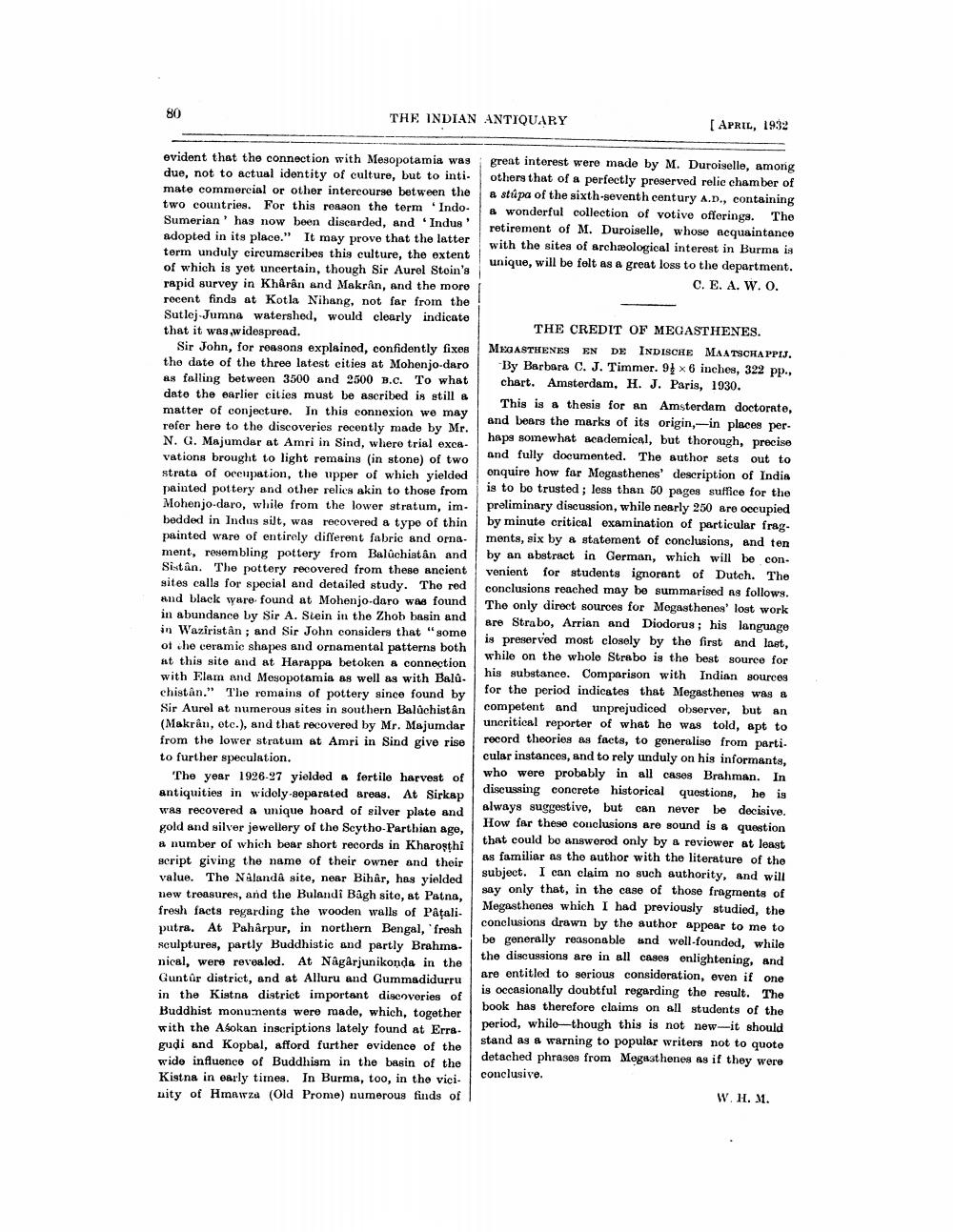________________
THE INDIAN ANTIQUARY
[ APRIL, 1932
great interest were made by M. Duroiselle, among others that of a perfectly preserved relie chamber of & stúpa of the sixth-seventh century A.D., containing & wonderful collection of votive offerings. The retirement of M. Duroiselle, whose nequaintance with the sites of archaeological interest in Burma ia unique, will be felt as a great loss to the department.
C. E. A.W..
evident that the connection with Mesopotamia was due, not to actual identity of culture, but to inti. mate commercial or other intercourse between the two countries. For this reason the term "IndoSumerian' has now been discarded, and Indus adopted in its place." It may prove that the latter term unduly circumscribes this culture, the extent of which is yet uncertain, though Sir Aurel Stein's rapid survey in Kharan and Makran, and the more recent finds at Kotla Nihang, not far from the Sutlej Jumna watershed, would clearly indicate that it was widespread.
Sir John, for reasons explained, confidently fixes the date of the three latest cities at Mohenjo-daro As falling between 3500 and 2500 B.C. To what date the earlier cities must be ascribed is still & matter of conjecture. In this connexion we may refer here to the discoveries recently made by Mr. N. G. Majumdar at Amri in Sind, whero trial exca. vations brought to light remains (in stone) of two strata of occupation, the upper of which yielded painted pottery and other relics akin to those from Mohenjo-daro, while from the lower stratum, im. bedded in Indus silt, was recovered a type of thin painted ware of entirely different fabric and orna. ment, resembling pottery from Baluchistan and Sistân. The pottery recovered from these ancient sites calls for special and detailed study. The red and black ware found at Mohenjo-daro was found in abundance by Sir A. Stein in the Zhob basin and in Waziristân; and Sir John considers that "some ot che ceramic shapes and ornamental patterns both at this site and at Harappa betoken a connection with Flam and Mesopotamia as well as with Balů. chistan." The remains of pottery since found by Sir Aurel at numerous sites in southern Balochistan (Makrån, otc.), and that recovered by Mr. Majumdar from the lower stratum at Amri in Sind give rise to further speculation.
The year 1926-97 yielded a fertile harvest of antiquities in widely-separated areas. At Sirkap was recovered a unique hoard of silver plate and gold and silver jewellery of the Seytho-Parthian age, a number of which bear short records in Kharosthi script giving the name of their owner and their value. The Nalanda site, near Bihar, has yielded new treasures, and the Bulandi Bagh sito, at Patna, fresh facts regarding the wooden walls of Patali. putra. At Paharpur, in northern Bengal, fresh sculptures, partly Buddhistic and partly Brahma. nical, were revealed. At Nagarjunikonda in the Guntar district, and at Alluru and Gummadidurru in the Kistna district important discoveries of Buddhist monuments were made, which, together with the Asokan inscriptions lately found at Erra. gudi and Kopbal, afford further evidence of the wido influence of Buddhism in the basin of the Kistna in early times. In Burma, too, in the viciuity of Hmawza (Old Prome) numerous finds of
THE CREDIT OF MEGASTHENES. MEO ASTHENES EN DE INDISCHE MAATSCHAPPIJ.
By Barbara C. J. Timmer. 91 x 6 inches, 322 pp., chart. Amsterdam, H. J. Paris, 1930.
This is a thesis for an Amsterdam doctorate, and bears the marks of its origin,-in places perhaps somewhat academical, but thorough, precise and fully documented. The author sets out to onquire how far Megasthenes' description of India is to be trusted ; less than 50 pages suffice for the preliminary discussion, while nearly 250 are occupied by minute critical examination of particular frag. ments, six by statement of conclusions, and ten by an abstract in German, which will be con. venient for students ignorant of Dutch. The conclusions reached may be summarised ng follows The only direct sources for Megasthenes' lost work are Strabo, Arrian and Diodorus; his language is preserved most closely by the first and last, while on the whole Strabo is the best source for his substance. Comparison with Indian gources for the period indicates that Megasthenes was a competent and unprejudiced observer, but an unoritical reporter of what he was told, apt to record theories as facts, to generalise from parti. cular instances, and to rely unduly on his informants, who were probably in all cases Brahman. In discussing concrete historical questions, he is always suggestive, but can never be decisive. How far these conclusions are sound is a question that could be answered only by a reviewer at least as familiar as the author with the literature of the subject. I can claim no such authority, and will say only that, in the case of those fragments of Megasthenes which I had previously studied, the conclusions drawn by the author appear to me to be generally reasonable and well-foundod, while the discussions are in all cases enlightening, and are entitled to serious consideration, even if one is occasionally doubtful regarding the result. The book has therefore claims on all students of the period, whilo—though this is not new-it should stand as a warning to popular writers not to quote detached phrases from Megasthenes as if they were conclusive.
W. H. M.




